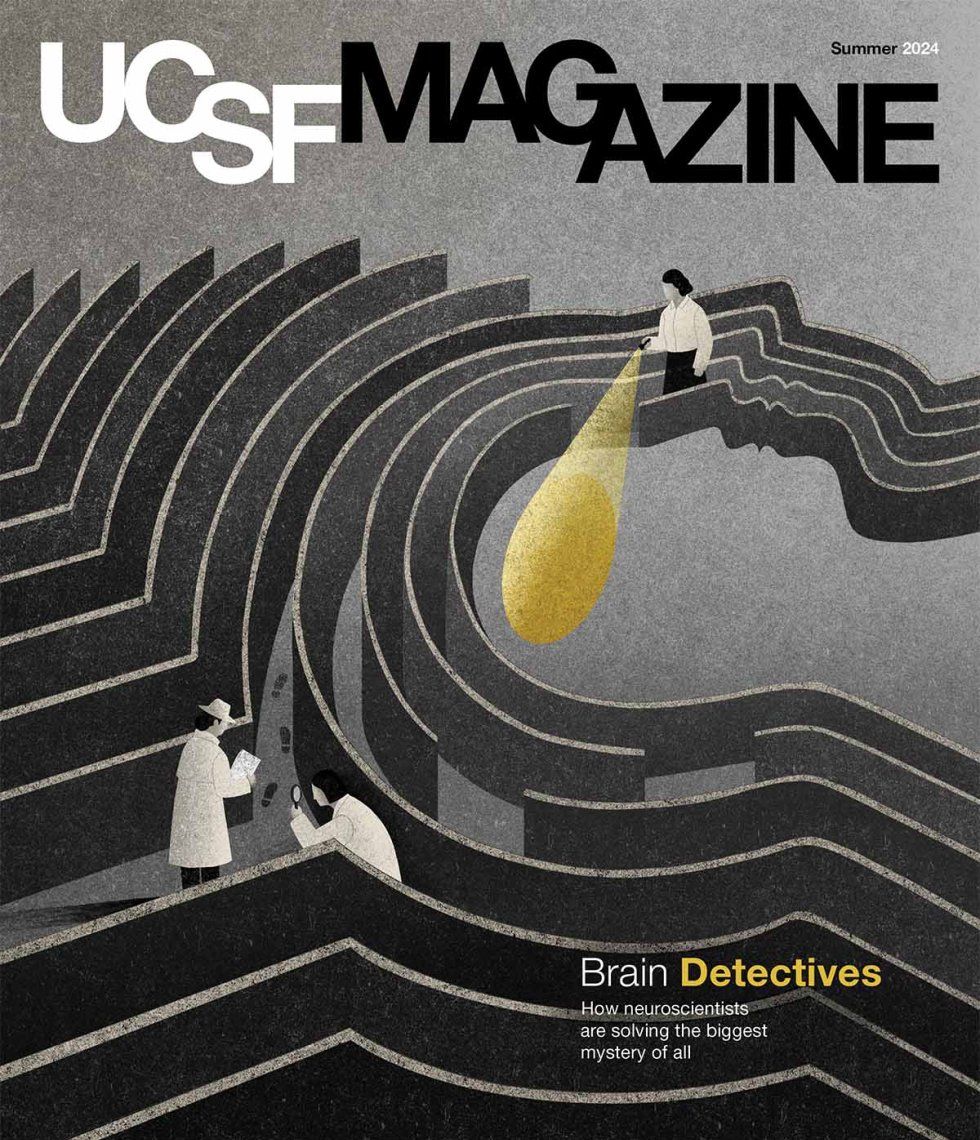Maybe a sense of calm comes with a walk in the woods surrounded by birdsong or during the quiet of your morning meditation or evening prayer. Maybe the rhythm of knitting or the earthy smell of gardening clears your head.
Science backs up what we know intuitively: Time we spend in nature or on calming practices or hobbies can benefit our mental and physical health. These activities rejuvenate us, right down to our body’s living building blocks: our cells.
A UC San Francisco-based team led by Alexandra Crosswell, PhD, and Elissa Epel, PhD, has woven together their own research and studies by others in various fields to connect the experience of, say, painting or practicing yoga to shifts in the nervous system and, subsequently, within our cells. To make this transition, our bodies and minds require certain conditions. But once these are met, the result, they say, is deep rest.
This truly restorative state – one never described before – confers benefits unattainable through routine rest and relaxation. In putting forward this concept, the team highlights the regenerative biological processes that protect us as we age.
“Deep rest is something our bodies need and deserve,” says Epel, a professor of psychiatry and vice chair of psychology. “With it, we improve our chances for healthy longevity.”
How chronic stress causes harm at the cellular level
To understand the benefits of deep rest, we must confront its counterpoint: stress. Surveys by the American Psychological Association suggest Americans experience plenty of this stomach-churning state. Almost half of adults who responded to a 2023 survey agreed at least somewhat with the statement “My stress makes going to work [or] school increasingly difficult.”
Stress, though it can interfere with our ability to function, originated in physiological mechanisms to help us meet challenges – whether escaping a pack of wolves or facing fallout from a major work mistake. Just like the fear of being eaten, the threat of losing your colleagues’ respect can put your body on high alert, triggering a cascade of responses.
Your nervous system hands over control of unconscious processes like breathing and digestion to its in-house crisis response coordinator: the sympathetic nervous system. This shift kicks off a series of energy-demanding changes that prime your body and mind for action. Your heart beats faster. Blood flow increases to your skeletal muscles, which tense up. Your production of hormones, such as cortisol and other energizing chemical messengers, surges. Your alertness intensifies.
Together, these and other shifts help ready you to fight or flee – even if you’re just anxiously awaiting a reply to your apologetic email while imagining dire scenarios.
A certain degree of stress is inevitable in life, Crosswell points out. “After years of studying stress, it became clear to us that we have to stop trying to get rid of it,” she says. “Stressful events are often outside our control, and our bodies’ response to them is natural and helpful.”
Too much stress, however, can cause harm. She and her colleagues argue that many Americans spend most of their waking hours in a moderately stressed-out state, driven by feelings of uncertainty about the future and lack of control. While no surprise to many of us, the idea the team explores – that we experience continual stress – represents a new direction in scientific thinking, which has traditionally considered relaxation the default human state.
Ideally, a stress-inducing crisis comes to a quick, clear ending. Maybe your apology at work is accepted, the mistake quickly forgotten. But problems in modern life often don’t come to quick, complete conclusions. Your boss may repeatedly deny requests for remote work. You and a loved one may frequently argue. You may struggle financially for years. Under such circumstances, stress can attenuate to a more moderate level, but it doesn’t stop.
While less taxing, residual stress still drains you. Maintaining an elevated heart rate or pumping out more cortisol than usual requires extra energy. This energy takes the form of molecules known as ATP, or adenosine triphosphate. Cellular organelles called mitochondria make ATP by using oxygen from the air we breathe to harvest energy from fats, proteins, and glucose derived from food we eat.
“Mitochondria are the source of the vital force that brings a cell to life and ultimately gives us our conscious mind, our emotions,” says Martin Picard, PhD, director of the Mitochondrial Psychobiology Group at Columbia University and one of Epel and Crosswell’s collaborators.
“Everything we experience is powered by the energy flow inside our cells,” he says, “and that flow takes place in mitochondria.”
While a single cell can contain hundreds of mitochondria, the organelles can generate only so much ATP – for reasons that remain unclear. So when your body goes on alert, a cell diverts its limited ATP supply to carry out the urgent functions the stress response demands, such as contracting the heart or synthesizing hormones. This robs it of energy for more routine but necessary tasks.
What’s more, studies have linked diseases, including diabetes, heart disease, and neurodegenerative disorders, with poor mitochondrial health. Picard suspects psychological stress has a similar effect, with mitochondria sustaining damage and becoming less productive when someone is under chronic strain.
Some prior studies and his own research with mothers caring for children on the autism spectrum, a source of chronic stress, support this idea. In a study led by Epel and described in Biological Psychiatry, Picard and others found that mitochondria in the mothers’ white blood cells had a reduced ability to transform energy into ATP. Cells face another potential consequence of damaged mitochondria: increased production of a potentially toxic byproduct of making ATP – chemicals known as reactive oxygen species (ROS). If not neutralized, ROS can harm our cells.
The effects of chronic stress extend to our genetic material as well. At the tips of chromosomes, repeating segments of DNA form telomeres. With assistance from proteins, telomere “caps” protect the integrity of these packets of genetic code – for as long as they can.
Each time a cell copies its genetic material so it can replicate, its telomeres lose a little DNA and shorten. Research started 20 years ago by Epel, with UCSF colleagues Nobel laureate Elizabeth Blackburn, PhD, and Jue Lin, PhD, shows that chronic psychological stress further shortens telomeres. This loss is a consequence of exposure to ROS, the release of hormones like cortisol, and inflammation. Molecular studies of cells substantiate this connection: By mimicking long-term exposure to the stress hormone cortisol, Picard has shown that cells respond by revving up their metabolisms, which shortens telomeres and hastens cell death.
The crux is that the rushed pace of modern life without sufficient time for restoration is a formula for accelerating our aging.”
Over time, such processes can have big consequences for our health. The deterioration of telomeres leads cells to stop dividing and to send out signals promoting more inflammation. Old cells with short telomeres and compromised mitochondria build up. The cumulative damage leaves us more prone to cancer and degenerative diseases, according to Epel.
“The crux is that the rushed pace of modern life without sufficient time for restoration is a formula for accelerating our aging,” she says.
States of the Cell
Illustration: Farah Hamade
States of the Cell
How stress – or deep rest – may change our body’s most fundamental units
Illustration: Farah Hamade
What it takes to turn stress off
Run-of-the-mill leisure activities, like spending time with friends or watching a movie, can provide some relief. Such pursuits may shut off your mind’s looping replays of, say, a relationship conflict or poor exam performance.
But whatever distraction they provide, these experiences probably won’t generate the restorative state that slows the biological clocks ticking in our cells, the team contends. Our unconscious mind can hold onto stress, and our body’s stress response may linger even into sleep.
But deep rest can effectively counter stress, the team argues. In their definition, deep rest is a psychological and physiological state during which our bodies can recover on a cellular level. In deep rest, formerly stressed cells restore themselves by performing the maintenance needed to keep such a complex machine, the human body, in working order.
Certain practices – those that cultivate inner well-being and quiet our minds – can open the door to this fully restorative state. Meditation and yoga are two of the most recognized contemplative practices, but many others exist.
Prayer, spiritual reading, the Japanese practice of therapeutic relaxation in nature known as forest bathing, and movement-based practices like tai chi and qigong can similarly calm and focus mind and body. And they don’t have to be quiet; drum circles or other group rituals offer comparable benefits. Other people may find hobbies like knitting or painting contemplative and soothing.
Regardless of form, these practices send signals telling their practitioners they’re safe, the researchers say. The practices turn off our subtle anticipation of threats like physical harm or emotional pain, including those brought on by others’ judgment or our own thoughts. They often accomplish this by tapping into our senses – the aroma of incense during a religious ritual, for instance. Likewise, caressing prayer beads during meditation or doing yoga in a candlelit room can convey safety by activating internal systems that have evolved to allow our bodies to rest. So, too, can the sights, sounds, and scents of a walk in nature.
Social safety cues also matter. Chanting in unison or listening to a calming voice may appeal to our auditory systems and social brains. A sense of belonging or a bond with others also fosters a feeling of safety. However, such perceptions can vary. Those who have experienced various types of discrimination may feel more at ease among others who share their social identity, for instance.
Beyond these external cues, such practices often look inward. Many encourage an awareness of the body through movement and measures like mentally scanning the body during mindfulness meditation. They may also emphasize focusing attention and managing emotions. In doing so, they free the mind from roiling thoughts and feelings.
And that’s not all. Either deliberately or as a side effect, contemplative practices also slow our breathing, a cardinal safety cue with potentially wide-ranging effects on our physiology, according to Epel.
For probably the past 10 years, a myth has been circulating that your only choice for managing stress is to meditate daily. But we’re saying there are many ways to reach the same state of deep rest and combat stress.”
“Having a slow, full exhalation is unique to a relaxed state. We don’t usually fully exhale as we’re rushing around our day feeling stressed,” she says.
The brain responds to slowed breathing, as well as other cues from contemplative practices, the researchers posit, thus prompting physiological changes that make true rest possible.
The commonalities across many contemplative practices mean that if you are considering starting one, you have plenty of choices, notes Crosswell, who conducted the research as an assistant professor at UCSF.
“For probably the past 10 years, a myth has been circulating that your only choice for managing stress is to meditate daily,” she says. “But we’re saying there are many ways to reach the same state of deep rest and combat stress. I hope that feels freeing for people.”
Deep rest restores our cells
Once received, safety signals prompt a shift in your nervous system, which switches off the ready-for-action sympathetic mode, the manager of the stress response. Then its neurological partner, the calming parasympathetic nervous system, takes over.
The unconscious changes that occur during this transition likely feed on themselves, according to the researchers. Slowing your breathing initiates a sense of calm and slows the heart rate. The vagus nerve, which passes information between the brain and internal organs, lets the brain know of this change. Your brain then switches off the stress response, allowing the parasympathetic nervous system to dominate, reinforcing the shift. Your heart rate continues to drop, digestion increases, your muscles relax. Meanwhile, your sense of ease grows, and you feel at peace. You may also experience a sense of deep connection – to yourself, the world at large, or a higher power.
You have now entered a distinct state – deep rest. The researchers introduced the concept in January 2024 in the journal Psychological Review. Though the term “deep rest” had previously been used for certain relaxation techniques, Crosswell and Epel’s concept ventures more deeply into our bodies’ physiology. Once in deep rest, they propose, our cells can redirect energy, in the form of ATP, to restoring themselves, from both the stress response and mundane wear and tear.
Cellular recycling is among the housekeeping activities that resume, they believe. Known as autophagy, that process occurs when our cells gather up old, damaged, malfunctioning parts, which are broken down by structures called lysosomes. The lysosomes then release the components to build fresh molecules and structures. The stress response interferes with this recycling process, which also declines as we age.
One form of autophagy focuses on sweeping up damaged mitochondria. Removing and replacing them not only ensures ATP production but also reduces the output of reactive ROS. This helps protect our cells from the damage ROS can cause. Studies have linked glitches in recycling mitochondria with numerous diseases, including Alzheimer’s and cardiovascular disease.
Likewise, deep rest may help protect our invaluable genetic material, according to Epel. Though aging and stress wear down the telomeres on our chromosomes, our cells also possess an enzyme called telomerase that adds DNA back onto those “caps.” By lengthening telomeres, telomerase prolongs their ability to protect chromosomes and the health of our cells. Studies show, says Epel, that telomerase’s activity increases during recovery from intense stress, whether the stress lasts for minutes or hours. Research also suggests that telomerase tends to increase during meditation retreats that take place over days or weeks, as well as after taking meditation classes for a month or more.
The new paradigm the team proposes – that contemplative practices signal safety to mind and body, triggering a truly restorative state whose benefits extend down to the level of cells – relies on their interpretation of years of studies in multiple scientific fields. Yet their synthesis of this research also points to a major oversight in our understanding of health and aging.
“Most of the focus has been on stress and disease,” says Epel, noting that the restorative processes that slow our cellular clocks and maintain our well-being over decades have received comparatively little attention. She describes the team’s work as “a call for action” for more research on deep rest as a key to healthy aging and healing.
The revitalization that occurs during sleep and the newly defined state of deep rest is “critically important” to healthy aging, she says. “It’s the other half of the equation.”





